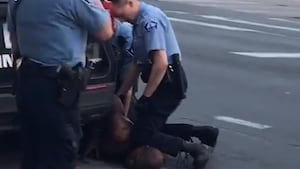For The Daily Beast’s membership drive, we're asking our reporters and editors to tell the stories behind some of their biggest stories.
Workdays during the coronavirus pandemic tend to blend together—punctuated only by brief trips to the kitchen for a sandwich or the rare walk outside in the sun.
The Daily Beast went remote in mid-March and while there was fear and confusion surrounding the virus, I was admittedly happy to sleep in and work from the comfort of my couch. But by May, that feeling was long gone. The pandemic forced many of us to expand our beats, work more flexible schedules, and write about mass death on a daily basis.
Then, a stomach-churning video of three white men chasing and shooting down Ahmaud Arbery, an unarmed Black man jogging on a residential Georgia street, went viral—and the attention shifted from the coronavirus to another deadly disease in our country: racial injustice.
The Arbery story dominated the news cycle for days, before protests started up in Kentucky over the death of another Black person: Breonna Taylor, an EMT worker who was shot in her home during a botched police raid.
Then, on May 25, Amy Cooper called the police on a Black bird-watcher in Central Park who asked her to leash her dog. That same day, amid mounting outrage over yet another flagrant example of white privilege and racial injustice, four Minneapolis police officers arrested George Floyd over a counterfeit $20 bill, one placing his knee on the unarmed Black man’s neck for nearly nine minutes as he pleaded for his life.
The 10-minute video of Floyd’s death made waves on social media almost immediately, bringing simmering anger to a full boil as hundreds of people in Minneapolis hit the streets demanding justice. I’ve covered horrific videos of police brutality in the past, but Floyd’s death was particularly shocking—not just his anguished cries but the repeated pleas from bystanders begging the four officers not to kill him.
The 46-year-old’s final pleas became a rallying cry, and it soon became clear that his death was leading to a national reckoning with race. I immediately began looking into the careers of the four officers—Derek Chauvin, Thomas Lane, Tou Thao, and J. Alexander Kueng—who were involved in the arrest.
Court records showed that Thao and Chauvin had both been involved in use-of-force incidents that resulted in complaints during their careers. All told, about two dozen complaints had been filed against the now-former police officers—but neither of them received anything more than a verbal reprimand.
For more exclusive access, insider interviews, and big scoops, become a Beast Inside member.
I found out that Thao, who stood by and held bystanders back as Floyd died, was involved in a violent incident six years earlier in which he brutally beat up an unarmed, handcuffed man during an arrest before escorting him to jail in only his underwear and T-shirt. Chauvin, who held his knee on the 46-year-old’s neck, was far more violent. After joining the force in 2001, he was one of six officers involved in the fatal shooting of 42-year-old Wayne Reyes, who allegedly stabbed two people before reportedly turning a gun on police.
It was during my look into Chauvin’s checkered cop career that I came across Ira Latrell Toles—who said the officer shot him during a 2008 domestic violence call.
With low expectations, I reached out to Toles on Facebook asking if he would be willing to talk about his encounter with Chauvin. He was, and during our conversation Toles recounted how, after a fight with the mother of his child, Chauvin barged into his home unannounced and beat him up in the bathroom before shooting him in the stomach. Then just 21, he told me he had blacked out during the assault and collapsed at the front door, where he remained bleeding until the paramedics came.
“He tried to kill me in that bathroom,” Toles told me. “If he was reprimanded when he shot me, George Floyd would still be alive.”
Toles said Chauvin’s bullet went through his groin and left butt cheek before hitting the bathroom wall. While he pleaded guilty to a misdemeanor charge, Chauvin continued his career with nothing more than a slap on the wrist.
The night the interview was published, Toles called me in disbelief that so many readers—and other news outlets—were interested in his story. After years of silently dealing with the repercussions of that night, Toles said he was grateful that he had the opportunity to share his pain.
By the time Toles and I spoke, protesters had already gathered across the country demanding greater transparency and accountability from police for the deaths of Black people. It was clear to all of us at The Daily Beast that the protests for Floyd would become an important chapter in history.
To cover the ongoing unrest, Beast reporters joined the protests at night and, with the help of amazing freelancers on the ground, we were able to showcase the day-to-day reality of some of these demonstrations—how journalists and residents were tear-gassed, hit with batons, and shoved to the ground by police clad in military gear. Meanwhile, some rogue residents willfully defied officers trying to enforce curfews, breaking windows and looting stores amid the chaos.
At least a dozen journalists at The Daily Beast covered the demonstrations in New York City and Washington, D.C., on one particularly chaotic night. Breaking News Editor Rachel Olding and Senior Reporter Lachlan Cartwright saw New Yorkers burn police cars in Union Square and loot storefronts in SoHo and Midtown as the city devolved into chaos after hours of peaceful protests for Floyd.
But when I hit the streets in lower Manhattan the next evening, I found a completely different New York.
In SoHo, an area usually teeming with New Yorkers and tourists, it was empty and silent. Minutes before the 8 p.m. curfew, police cars lined the streets of the neighborhood, where dozens of luxury stores were destroyed and looted the night prior. Within 15 minutes, over a dozen officers arrested a handful of people, including two scared teenagers who attempted to enter a Louis Vuitton store, in a show of force I have only seen in movies about revolutions.
When I asked how the night was going, one NYPD officer said: “Well, for one, we all are out tonight. I think tonight will be more calm.”
Floyd’s death eclipsed the coronavirus pandemic in a matter of moments—forcing us at the Beast to find the balance between two breaking news stories that are equally important to our readers. On a more personal level, it was a surreal time for both reporters and protesters—we all feared getting attacked by overzealous officers and contracting the virus while out in public.
When I went out, I had three editors’ phone numbers written on one arm in case I got arrested—and hand sanitizer in another. I was careful to keep my press pass visible to officers who were all too eager to arrest protesters after the curfew, but also wary about rogue residents who were smashing windows and throwing down phones to incite disorder.
Floyd’s story has been different than other instances of police brutality I’ve covered in the past in two major ways: The movement it inspired has shown little signs of dying down, and the 46-year-old’s killers were charged quickly. Unlike the five years it took the New York City police officer who strangled Eric Garner to death to face charges, in Minneapolis it took days.
These steadfast protests have put a spotlight on not just the inequities of the justice system and systemic racism in police departments, but on inequality in America as a whole. The movement has already led to changes in police departments across the country and how their officers use force—setting a new tone for how Americans will respond to police killings, racial injustice, and brutality.
After months of reporting on a pandemic from the confines of my one-bedroom apartment, I realized that while the coronavirus paralyzed the world, the Black Lives Matter movement has galvanized it. Across the globe, protests continue to push for action, changing how media organizations approach race, and forcing political leaders to address law enforcement reform.
That change was seen weeks later when Rayshard Brooks was fatally shot by an Atlanta police officer after he fell asleep in his car in a Wendy’s drive-thru lane. Within days, the officer who shot him was charged on 11 counts—and the other officer on the scene was charged with three.
Even in May, Toles told me that he felt Floyd’s death would finally bring change and reform that is necessary for Minneapolis and the country. All it took was outraged Americans taking matters into their own hands.
“We’ve all reached our tipping point. Water boils at 212 degrees,” he said. “We’re at 600.”
We’re able to cover the biggest stories on the planet because of the support of Beast Inside members. Join us today!










